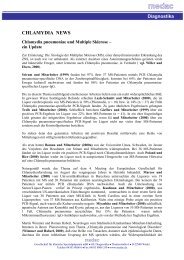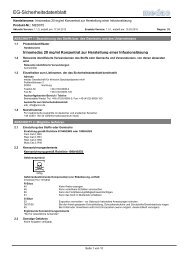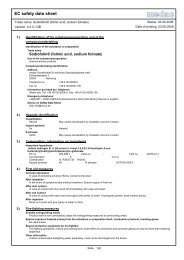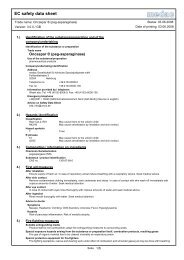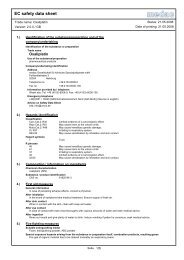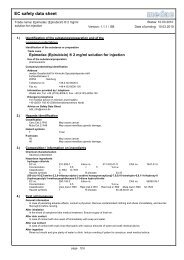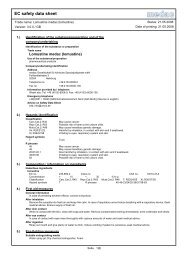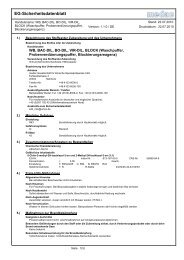Navirel - medac GmbH
Navirel - medac GmbH
Navirel - medac GmbH
You also want an ePaper? Increase the reach of your titles
YUMPU automatically turns print PDFs into web optimized ePapers that Google loves.
EC safety data sheet<br />
Trade name: <strong>Navirel</strong> 10 mg/ml Concentrate for the production of an<br />
Version: 2.0.0 / GB<br />
6.) Accidental release measures<br />
Seite 2(6)<br />
Status: 21.05.2008<br />
Date of printing: 21.05.2008<br />
Personal precautions<br />
Refer to protective measures listed in sections 7 and 8. Ensure adequate ventilation. Cordon and mark contaminated area.<br />
Personal protection equipment for removal of unintentional contamination or in the event of rupture :<br />
- Overshoes<br />
- liquid-proof protective long-sleeved coat with close-fitting sleeve-band<br />
- protective goggles<br />
- protective gloves<br />
- Protective face mask min. P2 according to the provisions of the professional organisation "Rules for use of breathing<br />
apparatuses"<br />
- cut cellulose in sufficient quantity<br />
- receptacle and waste container, shovel<br />
Environmental precautions<br />
Do not discharge into the drains/surface waters/groundwater. Do not allow to enter drains or waterways.<br />
Methods for cleaning up/taking up<br />
Kittake-up of liquid drugs spill:<br />
cover contaminated area carefully using disposable cloths or cellulose, so that the liquid is completely absorbed.<br />
take-up of dry solid matters:<br />
cover with several layers of cellulose contaminated area carefully over its whole surface, so that the cellulose can be wetted<br />
cautiously from above.<br />
; Take-up of glass breakage:<br />
Use of suitable means and use of an additional pair of protective gloves.<br />
Clean thoroughly contaminated areas. Remove immediately and appropriately soiling. Keep ready a decontamination kit. Take-up<br />
of liquid drugs spill.<br />
Cover contaminated area carefully using disposable cloth or cellulose, so that the liquid is completely absorbed.<br />
Take-up of dry solid matters.<br />
Cover with several layers of cellulose contaminated area carefully over its whole surface, so that the cellulose can be wetted<br />
cautiously from above.<br />
Take-up of glass breakage.<br />
Use of suitable means and use of an additional pair of protective gloves.<br />
Clean thoroughly contaminated areas.<br />
Additional informations (chapter 6)<br />
cytostatic substances can be inactivated according to the Barth procedure ruling the chemist’s (drugstore) production of cytostatics<br />
(chapter II-6, page 2-3).<br />
7.) Handling and storage<br />
Handling<br />
Advice on safe handling<br />
No special measures necessary if stored and handled as prescribed. Avoid formation of aerosols. [P_ID:8015380!]<br />
Advice on protection against fire and explosion<br />
No special measures necessary.<br />
Storage<br />
Requirements for storage rooms and vessels<br />
Store product in closed containers.<br />
Advice on storage assembly<br />
None known<br />
Further information on storage conditions<br />
Keep container tightly closed. Keep in a cool place.<br />
8.) Exposure controls / personal protection<br />
Exposure limit values<br />
N O N E<br />
Exposure controls<br />
Occupational exposure controls<br />
Handling of cytostatics / virusstatics calls always for separated, clearly marked working spaces in compliance with TRGS 525<br />
(technical provisions for hazardous substances).<br />
Personal protective equipment<br />
Respiratory protection<br />
If workplace exposure limits are exceeded, a respiration protection approved for this particular job must be worn. If ventilation<br />
insufficient, use a respiratory protection apparatus.<br />
Respiratory filter (part): min. P2<br />
Hand protection<br />
In case of intensive contact, wear protective gloves (EN 374). Sufficient protection is given wearing suitable protective gloves<br />
checked according to i.e. EN 374, in the event of risk of skin contact with the product . Before use, the protective glove should be<br />
tested in any case for its specific work-station suitability (i.e. mechanical resistance, product compatibility and antistatic properties).



